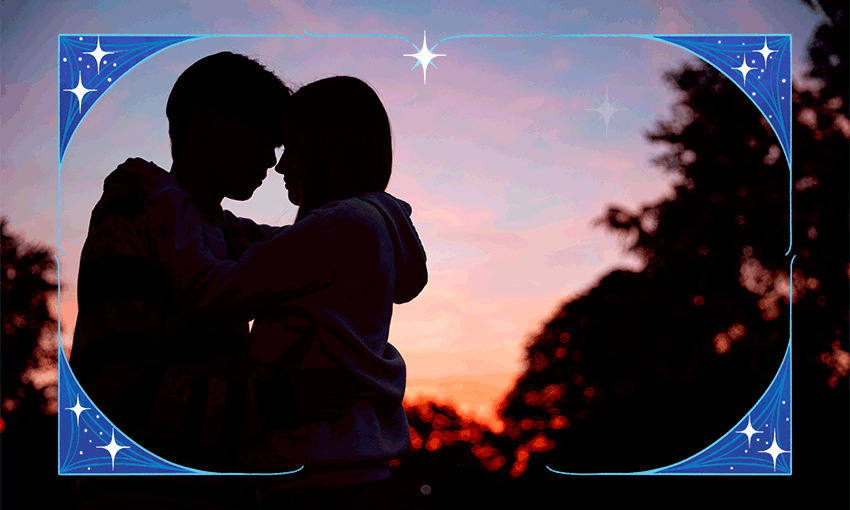In the week of Matariki, Airana Ngarewa pays tribute to Puanga.
Puanga (Rigel) is Taranaki’s tohu of the new year. In our rohe, it is said to be the oldest star in the sky which is why she leads these celestial bodies into te tau hou. The traditions surrounding her are almost as abundant as the stars themselves, each celebrating her relationship to the world as we know it.
Some have her as the wife of Rehua (Antares), the tohu of summer, and claim puawānanga (White clematis) as the child of these two lovers, the flower blooming in the months between their rising and setting. Others have her as the wife of another star, Takurua (Sirius), and claim them to have begotten the second brightest star in the night sky, Atutahi (Canopus). Together they are said to signal the time of cultivating kūmara while providing at the same time tohu of what the weather will do in the coming months.
Perhaps both kōrero are correct and like sometimes happened in the old days, Puanga had more than one husband. This may be where she gets her second name: Puanga Kairau. While popularly interpreted as Puanga of abundant food or Puanga of stored food, a less known interpretation is Puanga the keen lover. Before the arrival of missionaries, Māori had a very different relationship with sex, celebrating the act in haka and waiata and on pou. It should come as no surprise then that the old people would attribute such a title to this whetū.
Though less known, this interpretation of her name fits in more ways than one. Not only is there a potential for Puanga to have many lovers but her time in the sky is also associated with many tikanga tied to fertility. There are the kererū who were a significant source of kai to pregnant women. Miro berries bloom just before Puanga rises and soon make these birds fat and easy to catch. For those who couldn’t conceive, it was also a time to karakia in hopes of a fix. Then there are the literally procreative acts. Te tai ao at this time is wet and cold and it was not uncommon for husband and wife to seek warmth with each other.
So deep does the kōrero in and around Puanga stretch there is even an explanation for why during Winter the weather changes:
Ko Puanga i te Tahi o Pipiri
huaina te whare o Maruaonui
Puanga on the first of Pipiri
opens the house of Maruaonui
Those associated with strong winds, rain and storms reside in the house of Maruaonui which is why, after Puanga has released them, they visit our world, disappearing again when Puanga has disappeared.
Some have said this weather is the reason why many farewell their dead during this time. Just as the rain washes and cleanses the earth, it is thought the rain also washes and cleanses our mamae, particularly the mamae associated with losing a loved one, preparing us as the weather prepares the soil for another trip around the sun.
Others believe instead that Puanga is merely the new year star and even when the sisters can’t be seen, Matariki (Pleiades) remains the tātai whetū we farewell our loved ones too. Still yet there is also some kōrero that suggests we farewell those who have passed on at this time not just because Puanga or Matariki has risen but because Rehua has set. His setting in this way is likened to a person being laid to rest.
Specific to the Taranaki rohe, one kōrero tells that Puanga not only opens the whare of Maruaorua, it opens the gateway for those who have passed on to move into the next world. First though, their spirit must be released to follow Te Marunui o Whiti. This is the path the guide stone, Rauhoto Tapairu, followed when he led the defeated Mounga Taranaki away from the heart of te ika after he challenged Tongariro for the love of Pihanga. Along this journey, it is said their spirits will cross two significant landmarks before they rest at last at Hawaikitanga or join the night sky as stars. Firstly, Te Puke Whiti. Puke meaning hill and Whiti meaning crossing. It is said to be the guardian of past, present and future and the thing for whom the prophet Te Whiti-o-Rongomai III is named. Secondly, Pikopiko i Whiti. A famous lagoon on Hawaiki – the home of Māori before they migrated across the Pacific Ocean on their legendary waka.
Puanga is thus a multitude. She is the tohu of the new year; a wife with many husbands; the power that opens and closes the whare which holds the strong winds, rain and storms; a parent of both a flower and a star; a keen lover; the whetū that signifies it is time to let go of the last year, to let go of those who have passed on, and to welcome with both hands the coming of a new one.
Airana Ngarewa is a Māori political affairs reporter, creating public interest journalism funded through NZ On Air.
Follow our te ao Māori podcast Nē? on Apple Podcasts, Spotify or your favourite podcast provider.





